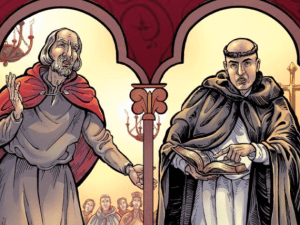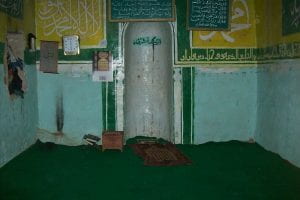Lately I’ve been looking at how retellings of the Hebrew Bible by medieval Iberian Jews, Christians, and Muslims reflect the mutual influence and tension between the three traditions (one on Adam and Eve, another on shared Biblical storyworlds). Here I am focusing on how the religious debates of the age play out in these texts, or rather: what do these retellings show us about how Medieval Iberians argued over which of these three faiths was supreme?

Nahmanides debates Friar Paul in the 1263 Disputation of Barcelona, from the graphic novel ‘Debating Truth’ by Nina Caputo and Liz Clarke (Oxford UP 2016)
Medieval Iberians of all religions engaged in polemics with their spiritual rivals. In the later Middle Ages, actual live disputations and debates (and some shouting matches that ended in fistfights or worse) fueled a genre of polemical treatises meant to legitimize one tradition at the expense of others. In the age of Christian crusade against Granada and an increasingly strident campaign to convert Muslim and Jewish subjects of Christian monarchs, these polemics were both increasingly reflective of daily practice and increasingly engaged with the actual exegesis, doctrine, and practice of rival groups, rather than shadowboxing a spectral abstraction of Christians, Jews, or Muslims.
While explicitly polemical treatises written expressly against one or another of the traditions put scripture in service to theological arguments, the polemical retellings of the Hebrew Bible we are about to see instead deploy theological arguments to reinforce their interpretation of scripture, privileging the narrative. Scholars of polemics point out that the polemic spirit infused many genres, especially biblical commentary (Talmadge 17; Trautner-Kromann 5), and we see these examples in that line of thinking. We are dealing with polemical Biblical narratives that demonstrate an awareness of and engagement with their sibling traditions. This engagement takes various forms, specifically in the representation of rival traditions, and through polemical representations of specific doctrines and practices meant to legitimize one tradition at the expense of the others.

‘The Feast Given by Joseph for his Brothers’ Francesco Morandini (1549). The Walters Art Museum art.thewalters.org. As in the General estoria, Joseph sits to one side by himself
One way of representing a given religious tradition is to identify a medieval religous group with a Biblical character or characters. The 13th-century Castilian universal history General estoria, compiled by Alfonso X of Castile, retells the story of Joseph in Egypt as an allegory for contemporary laws mandating that Jews and Christians not eat together. In the retelling, Joseph seats his Israelite brothers at tables separately from the Egyptians dining with them, explaining that Egyptian law forbade Jews to eat at the same table as Egyptians (Alfonso X I:8, xxi, 453), thus projecting the contemporary polemical atmosphere backward in time onto the Biblical text:
he ordered the tables set, his to one side, as if we were a man from a different religion and a strange land, and that of the Egyptians, who ate with him on his side, as befits natives of the land, and that of his brothers on their side, as befits foreigners, for at that time in Egypt it was an infraction of the law and as nonsensical that Egyptians eat with Jews who were not of their religion
mandó poner las mesas, la suya apartada, assí commo de omne d’otra ley e de agena tierra, e la de los de Egipto que comién con él en su cabo, assí commo de naturales del logar, e la de sos hermanos a su part, assí como de avenedizos, ca por quebrantamiento de ley e por cosa sin razón tenién estonces los de Egipto de comer ellos con los judíos que non eran de su ley. (Alfonso X I:8, xxi, 453)
We can see a similar process at work in the Jewish retelling of the Joseph story in the fourteenth-century Castilian Coplas de Yosef, which repeatedly refers to individual Israelites as judíos (‘Jews’) as opposed to Israelites or ‘Sons of Jacob,’ and collectively as judería (‘group of Jews’ and also ‘Jewish neighborhood’) (Minervini and Girón-Negrón 171, st. 216a, 173 n 216a).

stills from ‘History of the World, Part I’ (dir. Mel Brooks, 20th Century Fox, 1981)
In Muslim retellings of the Hebrew Bible, representation of Jews or Biblical Hebrews (standing in for contemporary Iberian Jews) reinforces the doctrine of taḥrīf (corruption of the Hebrew scriptures by Jews and Christians) and the moral and spiritual inferiority of non-Muslims in general. The doctrine of taḥrīf is allegorized in the sixteenth-century Aljamiado Dialogue of Moses with God on Mount Sinai, written for clandestine Muslims living under the prohibition of Islam in the age of Inquisition. Their Moses comes down from the mountain with ‘seven [not two] tablets of pearls and coral, on which the Torah was written’ (“Siete tablas de perlas y coral, en que ellas estaba escrito el at-tawrah” (Vespertino Rodríguez 174). This reinforces the traditional Muslim view that the Jews changed the Torah after it was received at Sinai.

Students studying Torah at Midreshet Aviv in Tel Aviv (timesofisrael.com 2013)
At other times, these retellings shift their focus to specific ritual practices, representing these in polemical ways to exalt one’s own or discredit those of others. In the 14th-century Jewish versification of the Joseph story, the Coplas de Yosef, Joseph asks his brothers to travel back to Canaan and prove to his father that Joseph is still alive by reminding his long-lost father Jacob of a study session the two had when Joseph was still living at home. The anachronic representation of Joseph studying Torah with Jacob (the events of the Joseph story in the Bible occur before those of the book of Exodus from which Jacob and Joseph here read) is meant as a bona fide to prove Egyptian Joseph’s identity both as a Jew (who studies Torah) rather than an Egyptian, and as the living brother of Jacob’s sons. He reminds his brothers:
He who loved me, my father the great scholar,
when he sent me to get you, and sent me away from his side, at the time, I read with him from a very precious book [Exodus]Aquél que me deseava, mi padre el gran letrado,
que cuando [a] vós me inviava espartióme de su lado, estonces con él meldava en un livro muy preçiado [Éxodo]” (Minervini and Girón-Negrón 175, st. 229).
This type of representation and instruction in ritual practice and prayer through Biblical narrative takes on a more crucial role in the Morisco community in the sixteenth century. With few opportunities for formal organized religious education, Moriscos depended in part on Aljamiado Biblical legends to reinforce Islamic doctrine and ritual praxis in context of persecution and Inquisition (Wood 43). In the 15th-century aljamiado Leyenda de Yusuf (‘The Legend of Yusuf’), the angel Gabriel visits Joseph in the pit into which his brothers have thrown him and teaches him Muslim prayers (Klenk 16–17; McGaha 174).

Interior of Mosque at the summit of Mount Sinai (photo: Premiero, 2007, wikipedia.org)
In the Diálogo de Moisés (‘Dialogue of Moses’) written in the same period, Moses ascends the mountain and spends forty days purifying himself spiritually before receiving the law. The scene describes him performing Muslim prayer, using the Arabic terms to describe the act of prayer: ṣalla (prayer), rakʿa (prostration), and sajada (to prostrate one’s self):
he went up to Mount Sinai and performed aṣ-ṣala in two rakʿas, and when he was sajjada’ed, Allah taʿāla approached him and said….
Subió al monte de Turiçina’a (Sinai) y hizo assala (oración) en el dos arrak’as (postraciones), y como estaba aççajado (postrado), acercólo Alla ta’ala, y díjole…” (Vespertino Rodríguez 168)
These examples of the representation in retellings of the Hebrew Bible of Jews, Christians, and Muslims, as well as their rituals and practices, demonstrates the extent to which the practices of the three traditions were at least as interdependent in their struggles with one another as they were in their common languages and vernacular culture. Against the backdrop of public disputations and written treatises reflecting this activity, polemical retellings of the Hebrew bible served as a common narrative stage for the drama of the three religions.
Works cited
- Alfonso X. General estoria. Edited by Borja Sánchez-Prieto, Fundación José Antonio de Castro, 2009.
- Klenk, Ursula, editor. La Leyenda de Yusuf. M. Niemeyer, 1972.
- McGaha, Michael D. Coat of Many Cultures: The Story of Joseph in Spanish Literature, 1200-1492. Jewish Publication Society, 1997.
- Minervini, Laura, and Luis Girón-Negrón. Las Coplas de Yosef. Entre la Biblia y el Midrash en la poesía judeoespañola. Gredos, 2006.
- Talmadge, Frank. “Introduction.” The Book of the Covenant of Joseph Kimḥi., translated by Frank Talmadge, Pontifical Institute of Mediaeval Studies, 1972, pp. 9–26.
- Trautner-Kromann, Hanne. Shield and Sword: Jewish Polemics against Christianity and the Christians in France and Spain from 1100-1500. Mohr, 1993.
- Vespertino Rodríguez, Antonio. Leyendas aljamiadas y moriscas sobre personajes bíblicos. Gredos, 1983.
- Wood, Donald Walter. “‘Tengo feuza en la piyadad de Allāh’: Piety and Polemic in an Aljamiado-Morisco ‘Companion in Paradise’ Narrative.” Medieval Encounters: Jewish, Christian, and Muslim culture in confluence and dialogue, vol. 26, 2020, no. 1, 2020, pp. 22–48, https://doi.org/10.1163/15700674-12340059.
This post is a version of a paper given at the 2022 meeting of the Medieval Academy. Thanks to Brian Catlos for organizing the panel on “Religious Texts and Confessional Integration in a Plural Mediterranean” (a session sponsored by the Mediterranean Seminar).
